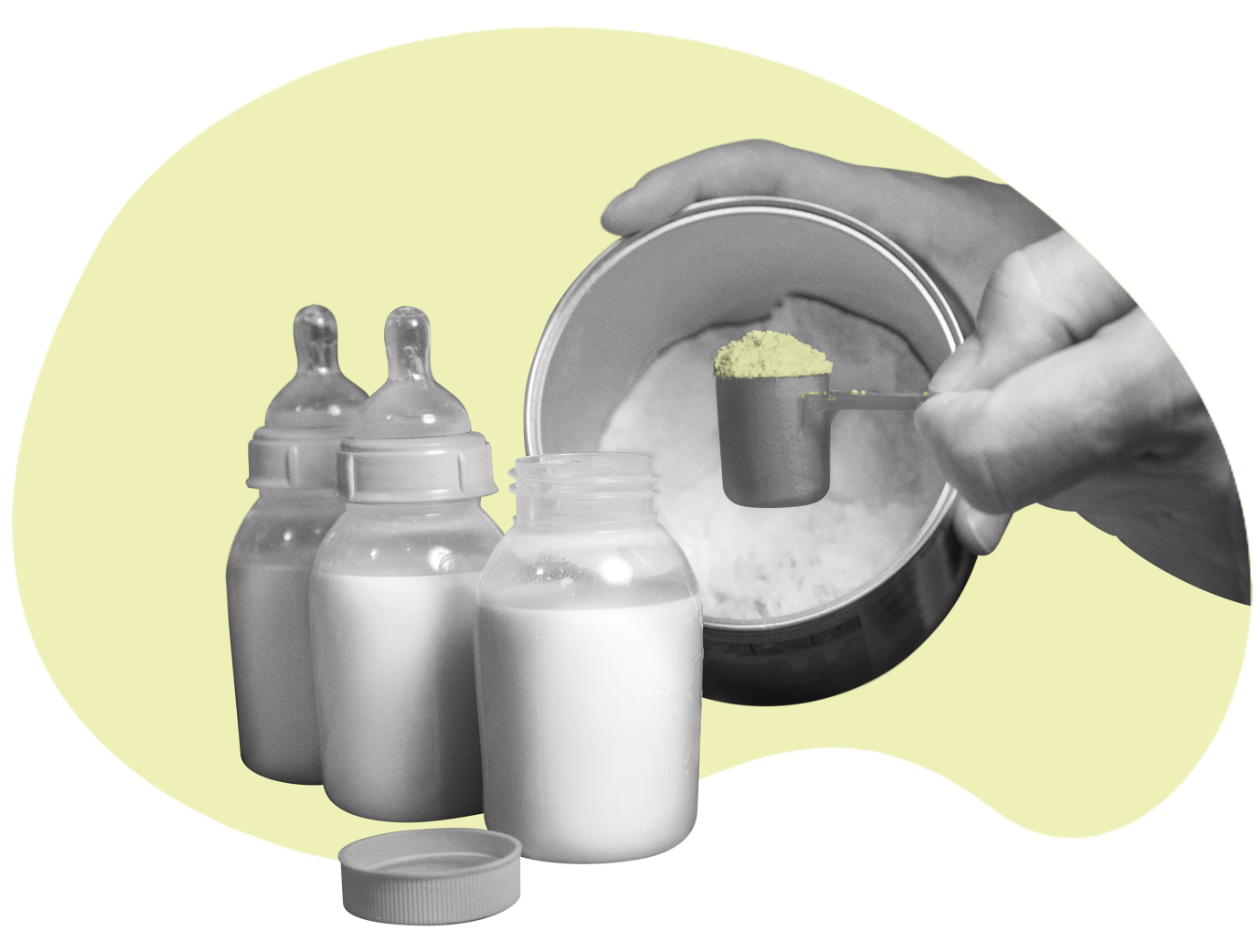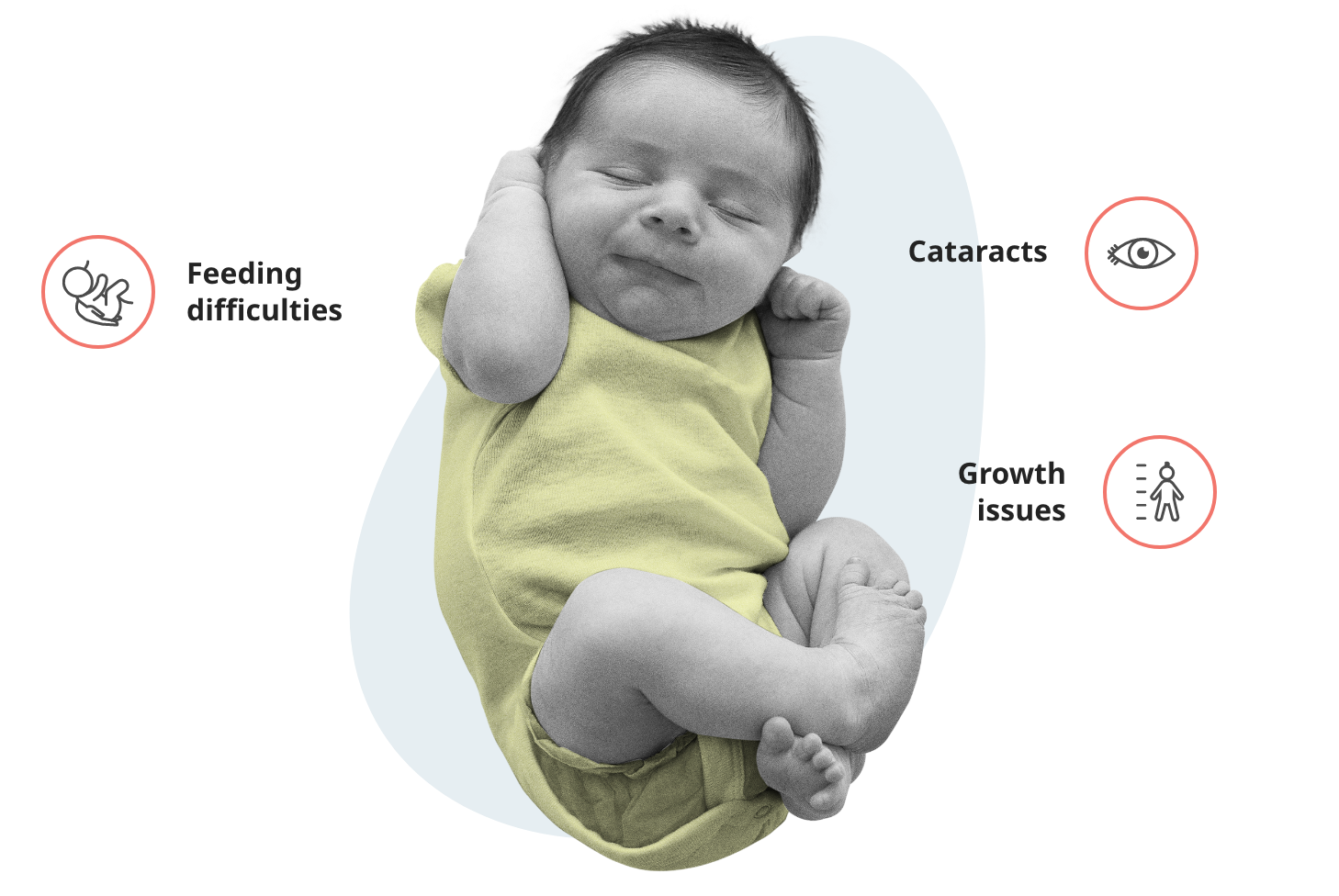This website uses cookies to help us give you the best experience when you visit and for certain analytics and marketing activities. By continuing to use this website, you consent to the use of these cookies. Please exit the website if you do not agree to such cookies being used. To find out more about how we use cookies, go to our Privacy Policy.
Galactosemia
in newborns
(ages 0 to 2 months)
Processing
The shock of diagnosis and what's next
Having your baby diagnosed with Classic Galactosemia can be upsetting and disorienting for you as a family. You may be feeling anxious as symptoms develop. And, you're probably thinking a lot about how you'll rise to the challenge of keeping your baby healthy.


Potential life-threatening symptoms
The first weeks of life hold some of the most serious threats to your baby's health. While Galactosemia has proven fatal in the past, taking decisive action with your baby's doctors can help provide the necessary care your baby needs.
Newborn screening
Newborn screening is a public health program conducted in all 50 states to detect serious conditions at birth, including Classic Galactosemia. However, timelines and methods for screening differ from state to state. For Galactosemia, screening typically starts with a blood spot taken from the baby’s heel to check for GALT enzyme activity. Classic Galactosemia will typically be diagnosed if GALT enzyme activity is low. At this point, the doctor may request the test be re-run to confirm diagnosis, or may take another blood sample for genetic testing. Some states may also perform an additional test to measure Total Galactose (galactose + Gal-1p).
When a doctor believes a newborn may have Galactosemia, the parents will be instructed to immediately switch their baby from milk to a soy or elemental formula, and to stop breastfeeding until the diagnosis can be confirmed. Affected newborns may appear healthy at birth, but can quickly develop severe illness if lactose is consumed during the time it takes to confirm the diagnosis (often days or weeks).
Confirmation testing looks for several clues that will confirm your child's diagnosis:
GALT enzyme activity
Lack of GALT enzyme activity indicates that the body is missing or has an inactive GALT enzyme that is needed to break down galactose. An enzyme activity test can determine whether there are no or low levels of GALT enzyme activity. A low level of GALT enzyme activity may allow a small amount of galactose to be metabolized.
Galactitol build-up in blood or urine
A blood or urine sample may be taken to determine if there is an excessive amount of galactitol, the toxic substance made when galactose cannot be processed by the body.
The presence of galactitol can support a diagnosis of Classic Galactosemia.
Genetic testing
A doctor who specializes in metabolic genetics may perform a test to understand which genetic mutation is responsible for your baby's Galactosemia.
To prevent serious illness and injury, your doctor will switch your baby from breast milk to soy or elemental formula.
Symptoms & monitoring
Short-term symptoms & long-term complications
These symptoms can occur immediately after birth as a result of consuming too much galactose (either through breast milk or dairy-containing formula). While waiting for confirmation of a Galactosemia diagnosis, your doctor will suspend dairy products and breastfeeding.
![]()

What types of testing will my newborn baby need?
For the first year of your baby's life, your doctor should monitor the amount of Gal-1p in their blood at 3 months and 9 months after beginning a Galactosemia-friendly diet.

Know Your Healthcare Team
Meet the team who may look after your baby's health
Metabolic geneticist
These experts specialize in metabolic disorders. They help to confirm a diagnosis of Galactosemia when your newborn's screening test is abnormal.
Dietitian
Your dietitian can provide guidance on your baby's Galactosemia-friendly diet. At this point, your dietitian can help you identify an appropriate substitute for dairy-based formula or breast milk.
Pediatrician
This is your baby's first doctor. They are trained to diagnose, treat, and provide ongoing care for a variety of childhood illnesses, both mild and severe.
Neonatologist
For some parents, their baby will be in the neonatal intensive care unit (NICU). The primary provider is the neonatologist, who specializes in the care of newborns with serious illnesses.
Ophthalmologist
Shortly after your baby's Galactosemia diagnosis, it is recommended that an ophthalmologist check for cataracts, which are caused by build-up of toxic galactitol.
Dietary needs
Feeding your newborn
Because the lactose in breast milk and dairy-based formulas causes life-threatening symptoms in newborns, it is critical that your newborn be given soy-based or elemental formulas, even if you're still waiting to confirm their diagnosis after an abnormal result from initial newborn screening.
Your baby still needs all of the same nutrients that all babies need to grow, so your doctor will recommend some formula choices available to you:

Powdered soy-based formula
This formula is very low in galactose because it is made from a protein extracted from soybeans. The powdered form of soy formula is generally preferred for babies with Galactosemia.
Liquid soy-based formula
This formula is also very low in galactose; however, most formulas have "carrageenan" in them. Carrageenan is an ingredient that contains "bound" galactose, which may or may not be absorbed into the body.
Elemental formula
This formula has been processed to break down all of the necessary nutrients into their simplest forms. This type of formula contains no detectable galactose; however, it can be much more expensive than soy-based formulas.
Galactosemia & breastfeeding
The decision to stop breastfeeding your newborn can be hard. And while breastfeeding is one way to build a connection with your baby, it's not the only way.

Feeding time can still provide an opportunity to connect through comfort and love with your new baby.
Touch, eye contact, and skin-to-skin contact also help foster the unique connection between you and your newborn.
These are all great ways for partners to take the opportunity to bond with newborns too.
Testimonials
Living with Galactosemia


Stay in the loop and get updates
Connect with Galactosemia Together:
References
- Abbott Laboratories. Understanding Galactosemia: a diet guide. 2010.
- American Academy of Family Physicians. Primary care. Accessed September 30, 2020. https://www.aafp.org/about/policies/all/primary-care.html
- American Academy of Pediatrics Healthy Children. What is a neonatologist? Updated November 2015. Accessed September 22, 2020. https://www.healthychildren.org/English/family-life/health-management/pediatric-specialists/Pages/What-is-a-Neonatologist.aspx
- Baby's First Test. Classic galactosemia. Updated October 2018. Accessed October 5, 2020. https://www.babysfirsttest.org/newborn-screening/conditions/classic-galactosemia
- Baby's First Test. Conditions Screened by State. Accessed November 30, 2020. https://www.babysfirsttest.org/newborn-screening/states
- Baby's First Test. Newborn Screening 101. Updated October 2018. Accessed October 12, 2020. https://www.babysfirsttest.org/newborn-screening/screening-101
- Baby's First Test. Screening Outcomes. Accessed November 30, 2020. https://www.babysfirsttest.org/newborn-screening/screening-outcomes
- Berry GT. Classic galactosemia and clinical variant galactosemia. In: Adam MP, Ardinger HH, Pagon RA, et al, eds. GeneReviews®. Seattle (WA): University of Washington; February 4, 2000.
- Berry GT. Galactosemia: When is it a newborn screening emergency? Mol Gen Metab. 2012;106:7-11.
- Boston Children's Hospital. Galactosemia. 2012. Accessed September 18, 2020. http://www.childrenshospital.org/conditions-and-treatments/conditions/g/galactosemia
- Coelho AI, Rubio-Gozalbo ME, Vicente JB, Rivera I. Sweet and sour: an update on classic galactosemia. J Inherit Metab Dis. 2017;40:325-342. doi:10.1007/s10545-017-0029-3
- Data on file. Applied Therapeutics, NY, NY 10017.
- Johns Hopkins Medicine. Metabolic genetics clinic: my newborn received an abnormal screen. Accessed September 22, 2020. https://www.hopkinsmedicine.org/institute-genetic-medicine/patient-care/genetics-clinics/metabolic-genetics-clinic.html
- Kotb MA, Mansour L, Shamma RA. Screening for galactosemia: is there a place for it? Int J Gen Sci. 2019;12:193-205.
- Krol KM, Grossman T. Psychological effects of breastfeeding on children and mothers. Leitthema. 2018;61:977-985. doi:10.1007/s00103-018-2769-0
- Metabolic disorders: nutrition support services. Children's Hospital of Orange County, University of California Irvine School of Medicine. Accessed September 22, 2020. https://www.choc.org/programs-services/metabolic-disorders/metabolic-disorders-nutrition/
- National Centre for Inherited Metabolic Disorders. Galactosaemia. Updated October 2019. Accessed October 29, 2020. http://metabolic.ie/wp-content/uploads/2019/08/Galactosaemia-Booklet.pdf
- National Organization for Rare Disorders. Galactosemia. Updated 2019. Accessed September 22, 2020. https://rarediseases.org/rare-diseases/galactosemia/
- Neuropsychological evaluation FAQ. University of North Carolina Chapel Hill. Accessed September 24, 2020. https://www.med.unc.edu/neurology/divisions/movement-disorders/npsycheval/
- Newborn Screening Laboratory Bulletin. Centers for Disease Control and Prevention. Reviewed February 21, 2014. Accessed October 12, 2020. https://www.cdc.gov/nbslabbulletin/bulletin.html
- Pyhtila BM, Shaw KA, Neumann SE, Fridovich-Keil JL. Newborn screening for galactosemia in the United States: looking back, looking around, and looking ahead. JIMD Rep. 2014:79-93. doi:10.1007/8904-2014-302
- Rajappa M, Goyal A, Kaur J. Inherited metabolic disorders involving the eye: a clinic-biochemical perspective. Eye. 2010;24:507-518.
- Welling L, Bernstein LE, Berry GT, et al. International clinical guideline for the management of classic galactosemia: diagnosis, treatment, and follow-up. J Inherit Metab Dis. 2017;40(2):171-176. doi:10.1007/s10545-016-9990-5
- What is sepsis? Centers for Disease Control and Prevention. Updated August 2020. Accessed September 22, 2020. https://www.cdc.gov/sepsis/what-is-sepsis.html
- World Health Organization. Newborns: improving survival and well-being. Updated September 2020. Accessed September 18, 2020. https://www.who.int/news-room/fact-sheets/detail/newborns-reducing-mortality
- Ystrom E. Breastfeeding cessation and symptoms of anxiety and depression: a longitudinal cohort study. BMC Preg Childbirth. 2012;12(36):1-2. doi:10.1186/1471-2393-12-36

